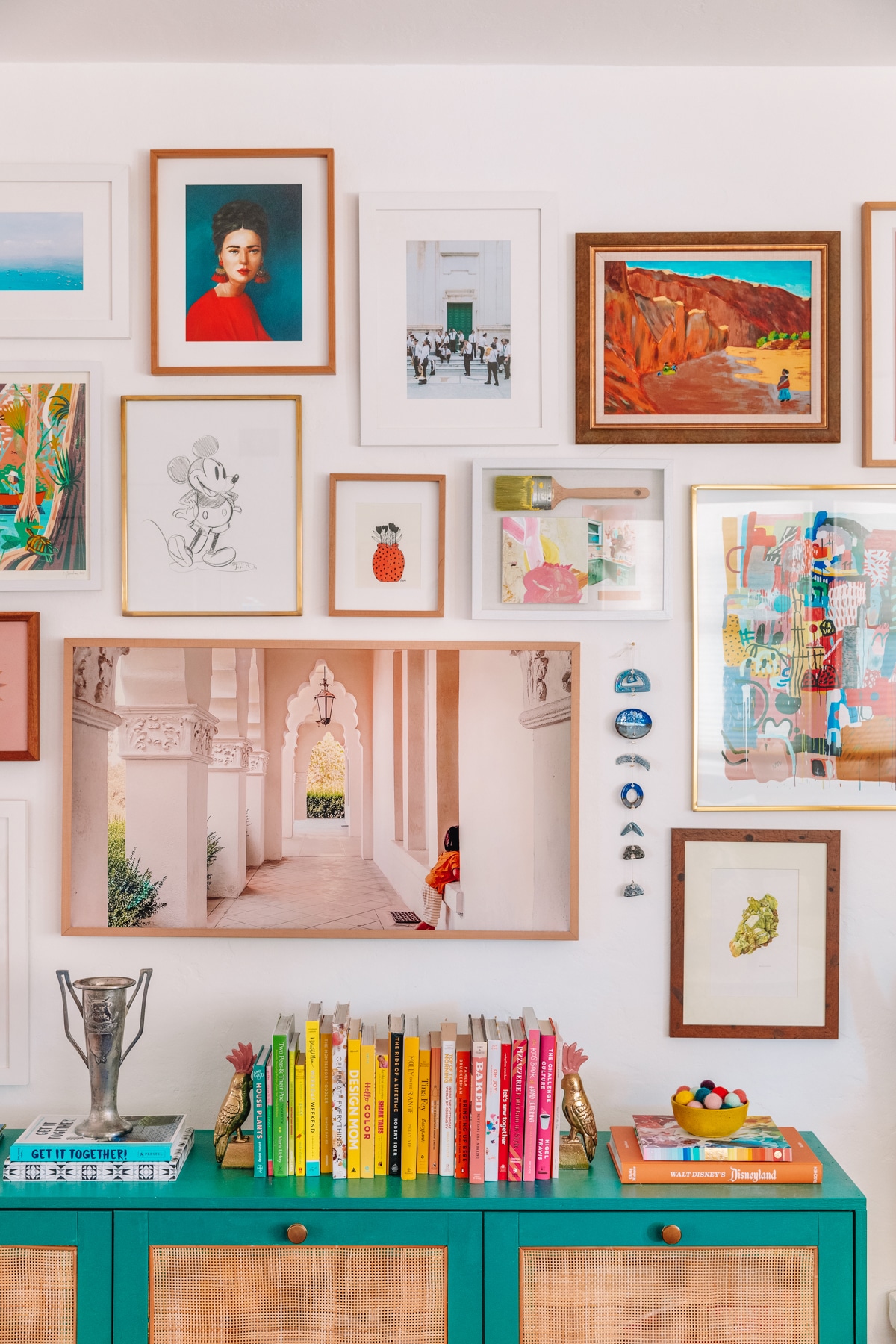Creating a gallery wall is an exciting way to bring your personality into your home. Start by choosing the right wall—somewhere spacious, like above a sofa or in a hallway—to avoid looking cluttered. Then, curate your collection by mixing art styles and including personal touches like family photos. Planning the layout is key; try arranging frames on the floor first or use paper templates to visualize how they’ll look on the wall. Hang your pieces with care, focusing on balance and spacing for a polished result. Lastly, don’t forget to enjoy decorating—it’s all about expressing yourself!
1. Selecting the Perfect Wall
 Credits: thecopperwolf.com
Credits: thecopperwolf.com
When it comes to creating a gallery wall, selecting the right wall is crucial. Look for a wall that is spacious enough to accommodate multiple frames without feeling cramped. Good spots include large walls in living rooms or above sofas where they can be a focal point. Hallways can also work well, especially for a series of smaller pieces. It’s important to avoid busy areas; placing a gallery wall near high-traffic zones can lead to a cluttered appearance and distract from the art. Think about the wall’s lighting, too—natural light can enhance your artwork, but direct sunlight might fade some pieces over time. Consider how the wall complements the room’s overall decor and your personal style. A wall that stands out or contrasts nicely with the surrounding elements can create a striking visual impact.
2. Curate Your Collection
Your gallery wall should reflect your taste and style. Start by mixing different styles of art and photography to create visual interest. For example, you can combine black-and-white family photos with colorful abstract paintings. This contrast adds depth and makes the wall more engaging.
Next, consider your color palette. Choosing a few repeating colors across your pieces can tie everything together, creating a cohesive look. For instance, if you have a vibrant piece of art with splashes of blue and yellow, try to incorporate frames or photos that include those colors.
Personal touches are essential. Include family photos that evoke memories, children’s artwork that showcases creativity, or memorabilia from travels that tell a story. These elements not only personalize your space but also make your gallery wall a conversation starter.
Lastly, aim for balance. While it’s great to mix styles and colors, ensure that the overall composition feels harmonious. You might group similar colors together or balance heavier-looking frames with lighter ones to achieve an appealing arrangement.
3. Layout Planning
 Credits: studiodiy.com
Credits: studiodiy.com
Planning your layout is key to a successful gallery wall. Start by visualizing your arrangement; you can do this by laying your pieces on the floor. This method allows you to see how they interact with each other in a space before committing to any holes in the wall. Use painter’s tape to outline the dimensions of your intended layout on the wall to get a sense of how it will look.
Consider different styles when arranging your pieces. An eclectic gallery wall thrives on variety, so mix and match different frame sizes and styles for a casual, artistic vibe. If you prefer a more structured look, a grid pattern with uniform frames can create a clean and organized appearance. For something more organic, an asymmetrical arrangement where you start with a central piece and build outward can add interest and movement.
Take your time during the layout phase; it’s the foundation of your gallery wall and sets the tone for the entire display. Don’t hesitate to rearrange until it feels just right, as this is your chance to play with creativity without any permanent commitment.
| Layout Style | Description | Ideal Use |
|---|---|---|
| Eclectic Gallery Wall | Mix and match different frame sizes and styles for a relaxed look. | Living rooms or casual spaces. |
| Grid Pattern | Use frames of the same size spaced evenly for a tidy appearance. | Entryways or formal areas. |
| Asymmetrical Arrangements | Avoid symmetry by starting with a central piece and filling around it. | Personalized spaces where creativity is encouraged. |
4. Hanging Your Art
 Credits: stylebyemilyhenderson.com
Credits: stylebyemilyhenderson.com
Start by hanging your largest or most favorite piece first, ideally at eye level. This will serve as your focal point. Once the anchor piece is in place, work around it. Aim for 2-3 inches of spacing between smaller frames and 5-10 cm for larger ones. Don’t stress about achieving perfect symmetry; an organic arrangement often feels warmer and more inviting.
Use the right hardware for hanging. Depending on the weight of your frames, you might need nails, hooks, or adhesive strips. Command strips are a great option for those who want to avoid making holes in the wall, especially in rented spaces.
After hanging your art, take a moment to step back and check the alignment. Using a level can help ensure everything looks straight. If something seems off, don’t hesitate to make adjustments. The key is to create a display that feels balanced and visually appealing.
- Use a measuring tape to determine the height for hanging.
- Decide on the spacing between each piece (usually 2 to 5 inches).
- Start with the largest piece and work your way down to smaller pieces.
- Use painter’s tape to outline where each piece will go before hanging.
- Ensure you have the right hanging hardware for the weight of your art.
- Use a level to make sure each piece is straight.
- Consider the line of sight; eye level is generally best for focal points.
5. Adding the Finishing Touches
To enhance your gallery wall, think about incorporating 3D elements that can add texture and depth. Items like wall hangings, mirrors, or even small shelves filled with decorative objects can create a more dynamic look. For instance, a round mirror can serve as a focal point, while shelves can display plants or books, making the wall feel more alive.
Another important aspect is to enjoy the process. There are no strict rules when it comes to personalizing your gallery wall. Allow your creativity to flow and don’t hesitate to rearrange pieces as your collection expands or your tastes change. This flexibility will make your gallery wall a living, evolving expression of your style.
6. Enjoy the Process
Creating a gallery wall should be a fun and fulfilling experience. As you select pieces that speak to you, remember that this is your chance to express your unique style. Don’t stress over making everything perfect; it’s more important that your gallery wall reflects who you are. If you find a piece that you love but it doesn’t quite fit your original plan, feel free to change things up. For instance, if a new photograph from a recent vacation catches your eye, it’s perfectly acceptable to swap it in. Your gallery wall can evolve over time, just like your taste. Enjoy the process of arranging, rearranging, and discovering new ways to showcase your collection. This can be a great opportunity to involve family or friends, making it a memorable group activity.
Frequently Asked Questions
1. What is a gallery wall?
A gallery wall is a collection of pictures, art, or other decorations arranged together on a wall to create a visually appealing display.
2. How do I choose the right photos for my gallery wall?
Pick photos that reflect your style and interests. You can use family pictures, travel snapshots, or art prints that resonate with you.
3. What layout should I use for my gallery wall?
Common layouts include grid patterns, salon-style arrangements, or a more casual, free-form look. Choose one that fits your space and personal taste.
4. How can I hang my pictures without damaging the wall?
Use removable adhesive strips or hooks that allow you to hang photos without leaving marks or damaging the paint.
5. What colors should I consider for frames on my gallery wall?
Choose frame colors that complement your photos and the room’s decor. Mixing different styles and colors can add interest.
TL;DR Creating a beautiful gallery wall enhances your home by showcasing your style. Start by selecting the right wall, curate a mix of art and personal pieces, plan your layout—consider options like eclectic or grid patterns. When hanging, begin with a central piece, maintain even spacing, and use proper hardware. Incorporate 3D elements for depth and enjoy the creative process as you reflect your personality.





